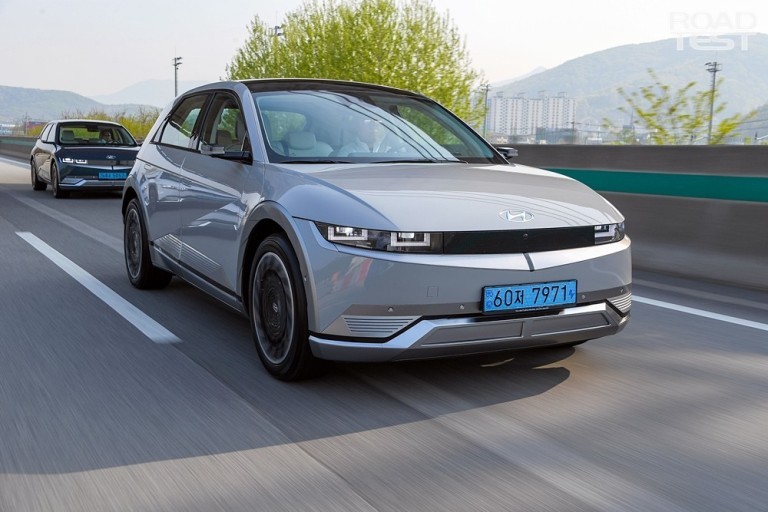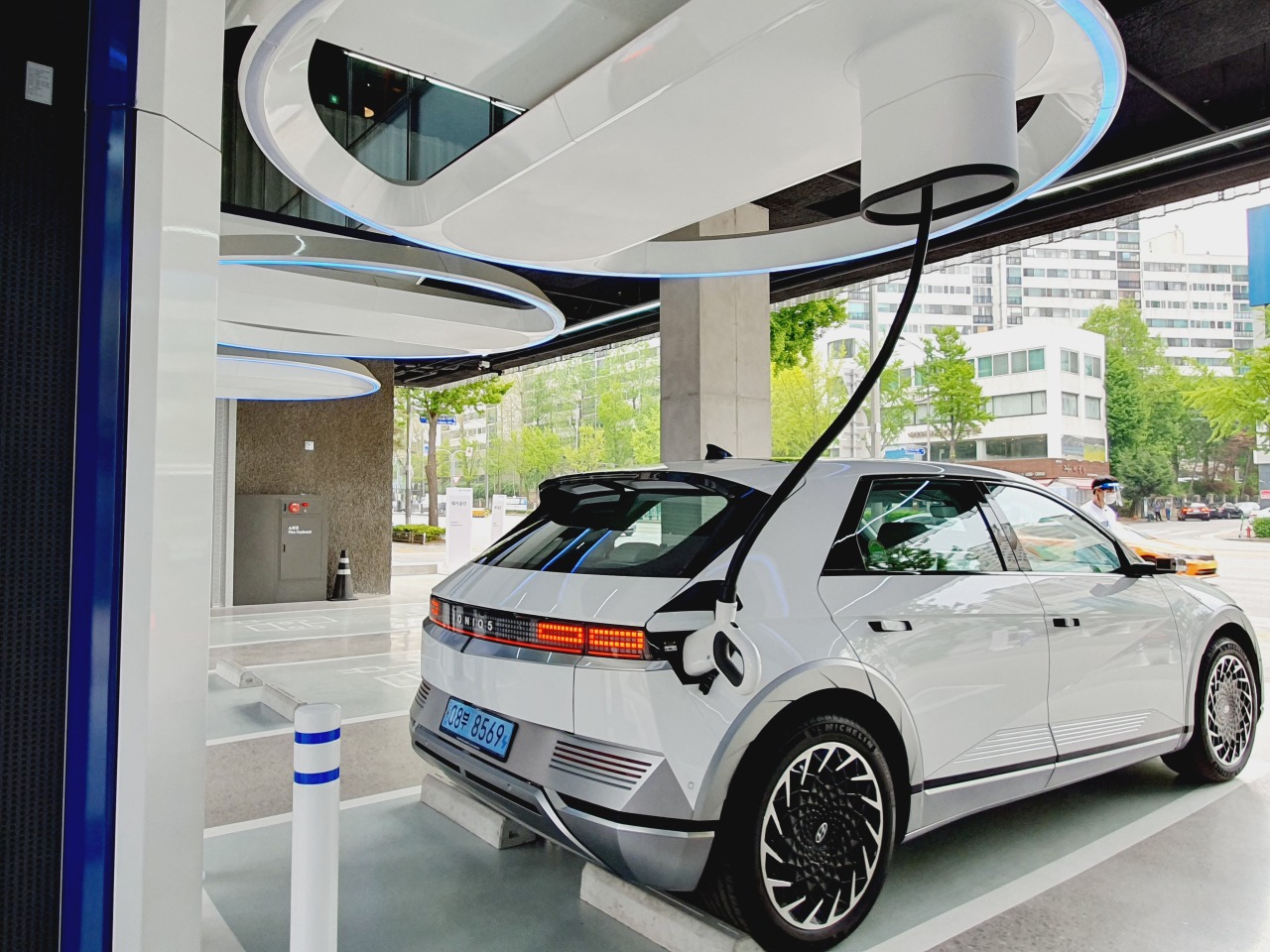
The Ioniq 5 driving (Hyundai Motor)

The Ioniq 5 is charged at Hyundai Motor’s charging station in Seoul’s eastern Gangdong-gu. (Bae Hyun-jung/The Korea Herald)

Two models of the Ioniq 5 are displayed in car camping settings in Namyangju, Gyeonggi Province. (Bae Hyun-jung/The Korea Herald)
For Hyundai Motor, the Ioniq 5 is not only the first all-electric vehicle adopting its exclusive electric vehicle platform, but also a key indicator of the company’s business outlook in the fast-growing battery-operated vehicles space.
Vying against global competitors such as Tesla, the automaker chose to optimize user experience through high-end interior materials, user-friendly interface and, most of all, an unrivaled, ultrafast charging system.
The Korea Herald has recently taken the Long Range 2WD Model Prestige Trim version of the Ioniq 5 for a test drive of around 80 kilometers. The corresponding model included options such as Comfort Plus, Parking Assist, digital side mirrors, Vision Roof, a built-in camera and Vehicle-to-Load function.
The course involved a round trip from Starfield Hanam, east of Seoul, to Namyangju, Gyeonggi Province, with a stopover at Hyundai Motor’s charging station in Gangdong-gu, eastern Seoul.
Making a strong first impression is the vehicle’s rectilineal and futuristic silhouette, which takes inspiration from Hyundai Motor’s first commercialized car Pony.
The key contributing factor is the clamshell hood that spans the entire width of the car, minimizing the panel gaps on the surface.
The auto flush door handles that bulge upon the car doors unlocking, along with the parametric pixels that appear on the head lamps, rear lights and wheels, complete the signature appearance of the new model.
The relatively low car floor, combined with the 3,000-millimeter wheelbase -- 100 millimeters larger than that of the large SUV Palisade -- creates a stable riding quality.
The shifting lever is located right behind the steering wheel in an electronic Steer by Wire format, allowing the driver to click forward or backward to manipulate the driving mode. The steering wheel was also noted for lacking the automaker’s signature “H” logo.
Those who take the wheel of an electric vehicle for the first time would be struck by the particularly smooth acceleration, minus the blunt sound, observed in other battery-operated vehicles.
Enabling this unique stability is the electric-global modular platform, or E-GMP, which is Hyundai Motor Group’s exclusive platform for electric vehicle operations. Unlike previous EV models, which installed a battery operation system to the conventional internal combustion engine frame, the Ioniq 5 is the first to be designed and built upon the E-GMP platform.
Excluding the under-the-hood engine room from the start, the E-GMP allows a lower floor and thus a wider interior space compared to peer models.
Drivers who have already experienced driving an electric vehicle would be attracted by “living space” factors and a number of options that advance driver convenience and safety.
First is the driver seat, which automatically slides back when the door opens to allow more space and readjust itself to the latest setting to best cater to the main driver’s needs.
The moveable center console, named “Universal Island,” can slide back and forth to optimize the space for both driver and passenger.
Replacing conventional side-view mirrors are side-view cameras and connected displays that offer a wider view of the side lanes and back side of the car.
Like the K8 sedan recently rolled out by sister brand Kia, the Ioniq 5 adopts a 12.3-inch-wide dashboard juxtaposed with an equal-size panoramic display, providing the driver a wide view.
But due to these newly added features, some of the control functions have had to be relocated, making it difficult for first-time users to detect right away.
For instance, the height of the head-up display had to be readjusted as its lower part was easily blocked by the steering wheel, but its controls were nowhere to be seen nearby the given display. Also, the seat ventilating function had to be manipulated via the infotainment display.
The provided front-wheel version took about 7.4-7.5 seconds to reach 100 kilometers per hour from zero, on the back of strong instantaneous acceleration even at low speed conditions. The four-wheeled edition is said to take 5.2 seconds to reach the 100 kph mark.
The eight units of ultrafast EV chargers provide 350 kilowatts in charging capacity -- the fastest available so far -- and can add 100 kilometers to the driving range with just five minutes of charging for models with the 800 volt system.
A unique feature of the charging station is the charging connector that descends from the rotating ceiling, alleviating the user’s physical burden.
Unfortunately, it was impossible to witness the charging speed from the 70 percent to 80 percent capacity, as organizers limited the charging ceiling to 70 percent, taking into account the total driving distance. Charging speed is supposed to slow down in the given range as the total electricity charging amount approaches the 100 percent level.
The charging price was 299 won ($0.27) per kilowatt and Hyundai Motor Group car owners can get a 23 percent discount during the early-stage promotion period by using the group’s exclusive Hi-Charger app.
The Ioniq 5 achieved 23,760 units in first-day orders in February and 41,779 units in total order volume as of the end of the first quarter. The heated market response even triggered concerns that the government’s subsidies for electric vehicles may prematurely run out, especially as the carmaker put off its production timeline amid the lack of automotive semiconductors.
By Bae Hyun-jung (
tellme@heraldcorp.com)








